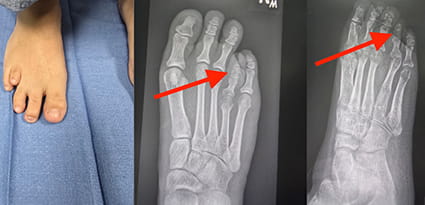
JHAH becomes first hospital in Eastern Province to offer routine toe-lengthening surgery for brachymetatarsia
Corrective plastic surgery is now available to all Johns Hopkins Aramco Healthcare patients who suffer from this foot deformity.
Johns Hopkins Aramco Healthcare (JHAH) has become the first hospital in the Eastern Province to offer routine corrective surgery for brachymetatarsia, a foot deformity that causes a patient’s toe to appear significantly shorter than the others.
Dr. Samer Bondokji, a consultant podiatric surgeon at JHAH, who is recognized for his expertise in limb-lengthening surgery and complex foot reconstruction, performed the hospital’s first toe-lengthening procedure on a brachymetatarsia patient in August last year. JHAH is now offering metatarsal lengthening surgery as a routine service to all patients who suffer from the deformity.
Patients with brachymetatarsia have one or more metatarsals — bones in the middle of the foot — that are significantly shorter than the others. This makes one or more of their toes look unusually short. Brachymetatarsia is most common in the fourth metatarsal, which affects the toe next to the little toe.
Brachymetatarsia can cause a patient pain if their shortened toe points upwards or overlaps with other toes and rubs against their shoe. The condition can change the way a patient uses their affected foot when walking, leading to weight being distributed unevenly and causing pain or discomfort elsewhere in the foot.
Brachymetatarsia has also been known to create psychological issues for patients, especially those who wear open-toed footwear.
“I know of brachymetatarsia sufferers who push their feet into the sand at the beach because they are embarrassed to show their stunted toe,” Dr. Bondokji said. “Others do not wear open-toed shoes or sandals. These same patients often experience unnecessary pain when they walk.
To bring a patient’s toe into line with the others, a surgeon cuts the shortened metatarsal bone and attaches a device known as an external fixator. The patient is discharged the same day. While at home, the patient makes small adjustments to the fixator every few days to slowly lengthen the metatarsal bone.
After about 12 weeks, when the metatarsal has reached the desired length and the new bone has strengthened sufficiently, the patient visits the outpatient clinic to have the fixator removed. They can then walk out of the clinic wearing protective shoes, and within a few days, they are able to wear the footwear of their choice.
